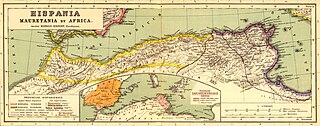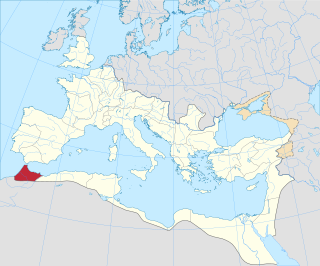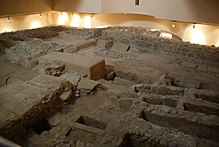Abila, also spelled Abyla, may refer to:

Ceuta is a Spanish autonomous city on the north coast of Africa.

Mauretania is the Latin name for a region in the ancient Maghreb. It stretched from central present-day Algeria westwards to the Atlantic, covering northern present-day Morocco, and southward to the Atlas Mountains. Its native inhabitants, of Berber ancestry, were known to the Romans as the Mauri and the Masaesyli.

Tangier is a city in northwestern Morocco, on the coasts of the Mediterranean Sea and the Atlantic Ocean. The city is the capital of the Tanger-Tetouan-Al Hoceima region, as well as the Tangier-Assilah Prefecture of Morocco.

Siga was a Berber and Roman port located near what is now Aïn Témouchent, Algeria. Under the Roman Empire, it was part of western Mauretania Caesariensis, bordering Mauretania Tingitana.

The Rif or Riff, also called Rif Mountains, is a geographic region in northern Morocco. It is bordered on the north by the Mediterranean Sea and Spain and on the west by the Atlantic Ocean, and is the Homeland to the indigenous people of the Rifians people. Historically, it belonged to the Rif Republic and its president, Abd el Krim, who led the Rif War from 1920 to 1927 and against a Spanish colonial empire, the Rif region was Historically a Spanish colony by the Spanish colonial empire in Africa. This mountainous and fertile area is bordered by Cape Spartel and Tangier to the west, by Berkane and the Moulouya River to the east, by the Mediterranean to the north, and by the Ouergha River to the south. The Rif mountains are separated into the eastern Rif mountains and western Rif mountains.

Mauretania Tingitana was a Roman province, coinciding roughly with the northern part of present-day Morocco. The territory stretched from the northern peninsula opposite Gibraltar, to Sala Colonia and Volubilis to the south, and as far east as the Mulucha river. Its capital city was Tingis, which is the modern Tangier. Other major cities of the province were Iulia Valentia Banasa, Septem, Rusadir, Lixus and Tamuda.

Tingis or Tingi, the ancient name of Tangier in Morocco, was an important Carthaginian, Moor, and Roman port on the Atlantic Ocean. It was eventually granted the status of a Roman colony and made the capital of the province of Mauretania Tingitana and, after Diocletian's reforms, the diocese of Hispania.

The Muslim conquest of the Maghreb continued the century of rapid Muslim conquests following the death of Muhammad in 632 and into the Byzantine-controlled territories of Northern Africa. In a series of three stages, the conquest of the Maghreb commenced in 647 and concluded in 709 with the Byzantine Empire losing its last remaining strongholds to the then-Umayyad Caliphate under Caliph Al Walid Ibn Abdul Malik.

Tamuda was an ancient Berber city and military camp in Mauretania Tingitana. It is located 6 km west of the present-day Tetouan in northern Morocco. Stone ruins from the site are found by the south bank of the Martil Valley. It was considered a city in accordance with the rules of urbanization of the time.
Aedemon was a freedman of Berber origins from Mauretania who lived in the 1st century AD. Aedemon was a loyal former household slave to the client King Ptolemy of Mauretania, who was the son of King Juba II and the Ptolemaic Princess Cleopatra Selene II.

Rusadir was an ancient Punic and Roman town at what is now Melilla, Spain, in northwest Africa. Under the Roman Empire, it was a colony in the province of Mauretania Tingitana.

Iulia Constantia Zilil was an ancient Roman-Berber city in Dchar Jdid, located 40 km southwest of Tangier and 13 km northeast of Asilah. It was one of the three colonias in Mauretania Tingitana founded by emperor Augustus between 33 and 25 BC for veterans of the battle of Actium.

Iulia Valentia Banasa was a Roman-Berber city in northern Morocco. It was one of the three colonias in Mauretania Tingitana founded by emperor Augustus between 33 and 25 BC for veterans of the battle of Actium, on top of a Mauretanian village. The site was in fact already occupied by the local Amazigh people from the 4th century BC, or perhaps earlier.
![<span class="mw-page-title-main">Thamusida</span> Berber, Carthaginian, and Roman river port near [[Kenitra]], [[Morocco]]](https://upload.wikimedia.org/wikipedia/commons/thumb/d/d4/Thamusida%2C_Mauretania_Tingitana%2C_Morocco_%2838384660375%29.jpg/320px-Thamusida%2C_Mauretania_Tingitana%2C_Morocco_%2838384660375%29.jpg)
Thamusida was a Berber, Carthaginian, and Roman river port that was near the present-day towns of Kénitra and Mehdya in Morocco. Under the Roman Empire, it formed a part of the province of Mauretania Tingitana.
Julian, Count of Ceuta (Spanish: Don Julián, Conde de Ceuta,, Arabic: يليان, was, according to some sources, a renegade governor, possibly a former comes in Byzantine service in Ceuta and Tangiers who subsequently submitted to the king of Visigothic Spain before secretly allying with the Muslims. According to Arab chroniclers, Julian had an important role in the Umayyad conquest of Hispania, a key event in the history of Islam, and in the subsequent history of what were to become Spain and Portugal.

Iulia Traducta was a Roman city in Andalusia, Spain, on the site of the modern Algeciras.

Iulia Campestris Babba is a Mauretanian city created as Roman colony around 30 BC by emperor Augustus. Its actual location is currently unknown, though its existence is confirmed by the literature.
The following is a timeline of the history of the city of Tangier, Morocco.

The Limes Mauretaniae was a portion of a 4,000-kilometre (2,500 mi) Roman fortified border (limes) in Africa approximately 100 kilometres (62 mi) south of the modern day Algiers.
















![<span class="mw-page-title-main">Thamusida</span> Berber, Carthaginian, and Roman river port near [[Kenitra]], [[Morocco]]](https://upload.wikimedia.org/wikipedia/commons/thumb/d/d4/Thamusida%2C_Mauretania_Tingitana%2C_Morocco_%2838384660375%29.jpg/320px-Thamusida%2C_Mauretania_Tingitana%2C_Morocco_%2838384660375%29.jpg)




